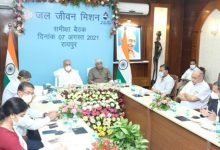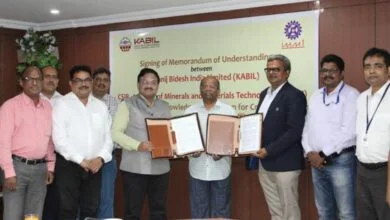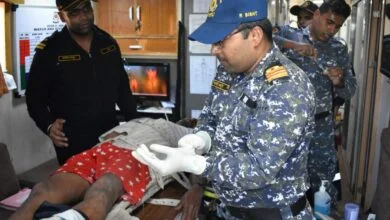Jal Jeevan Mission: Himachal Pradesh presents Annual Action Plan

Himachal Pradesh to become ‘Har Ghar Jal’ State by July 2022
The State of Himachal Pradesh presented their Jal Jeevan Mission Annual Action Plan for the financial year 2021-22 before the national committee chaired by Secretary, Ministry of Jal Shakti through video conference. While presenting their plan, ‘Jal Shakti Vibhag’, the Government of Himachal Pradesh reiterated its commitment to achieving the ‘Har Ghar Jal’ target by July 2022.
The State has 17.04 lakh rural households, out of which 13.02 lakh (76.41%) have assured tap water supply. Since the announcement of Jal Jeevan Mission (JJM) in August 2019, over 5lakh tap water connections have been provided and so far 8,458 villages (46.78%) in the State have been declared ‘Har Ghar Jal’, which means every rural household in these villages has tap water supply. In 2021-22, Himachal Pradesh plans to provide 2.08 lakh tap water connections across the State.
Based on the plan, the State was requested to make more districts 100% saturated. Three districts of the State i.e. Kinnaur, Una, and Lahul&Spiti are ‘Har Ghar Jal’ districts. All the schools and Anganwadi centers have already been covered under the 100-day campaign and all these institutions in the State have piped water supply.
JJM is a flagship program of the Union Government being implemented in partnership with the States with the objective to provide tap water connection in every rural household by 2024. In 2020-21, Himachal Pradesh was allocated a Central grant of Rs. 326 Crore to provide assured tap water supply in rural areas, and State had drawn Central fund of Rs. 548 Crore, which includes an incentive grant of Rs. 221Crore owing to better performance.
In the 2021-22, the State is likely to get about Rs. 700Crore as a Central grant to take up various works. Under JJM, efforts are made to dovetail all available resources by the convergence of different programs viz. MGNREGS, SBM, 15thFinance Commission Grants to PRIs, CAMPA funds, Local Area Development Funds, etc. The committee suggested that the State should utilize various resources through convergence for water supply, water recycling, greywater management, source strengthening including spring shed development, etc.

Under Jal Jeevan Mission, in 2021-22, in addition to Rs 50,011 Crore budgetary allocation, there is also Rs 26,940 Crore assured fund available under the 15th Finance Commission tied-grant to RLB/ PRIs for water & sanitation, matching State share and externally aided as well as State-funded projects. Thus, in 2021-22, more than Rs. 1 lakh Crore is planned to be invested in the country on ensuring tap water supply to rural homes.
JJM focuses on the development of the Village Action Plan (VAP) and the formation of the Village Water and Sanitation Committee (VWSC) for every village so that the local village community plays a key role in planning, implementation as well as operation and maintenance of the in-village water supply infrastructure created for them. This ensures a bottom-up approach with the participation of the local community.
Through community engagement, the resources created in the villages/ habitations are handed over to the Panchayats or VWSC for monitoring, surveillance and upkeep. Because of small village sizes, VWSCs are being constituted at the Gram Panchayat level in Himachal Pradesh. The state has so far constituted 3,213 VWSCsand planned for the remaining 402in 2021-22. So far, 16,645 Village Action Plans have been prepared.
The State is planning to engage various experts/ support staff at State and District level. In addition to it, State also intends to conduct training/ capacity building for 36,131 people from SWSM/ DWSM, Engineering cadre, Management cadre, ISAs, block-level officials, VWSCs/ Pani Samiti members, GP/ village level key stakeholders, etc. Further, as per plan 4,000 local persons will be skilled as a plumber, fitter, and electrician in 2021-22. This trained workforce shall in turn be used to build the water supply infrastructure. It will be instrumental in boosting the rural economy and providing employment to youth within the region.
Under JJM, water quality testing laboratories at district &State levels are given priority and the community is being encouraged for surveillance of water quality. ‘Jal Shakti Vibhag’ is facilitating to empower and engage with the community. For this, an action plan has been taken up to ensure timely procurement and supply of Field Test Kits to the community, identification, and training of at least five women from the local community, use of Field Test Kits, and reporting the test result findings. In 2021-22, State plans to set up 11 new laboratories and NABL accreditation of 34 laboratories.
The State officials were advised for testing of drinking water sources for chemical and bacteriological contamination as per the standard protocol. In the times of the COVID-19 pandemic as well as the ensuing summer season, it has become important to deal with the issue of water scarcity & contamination. Clean water will promote better hygiene and a functional tap in household premises will ensure social distancing by avoiding crowding at public stand posts. NJJM team emphasized revisiting difficult areas including sub-Zero terrain to take a stock of water supply infrastructure created under JJM so that those remain functional throughout the year.
Annual action planning exercise with States/ UTs is carried out by the national committee chaired by the Secretary, Ministry of Jal Shakti, AS&MD (NJJM), and other members from different Central Ministries/ Departments and NITI Aayog. Rigorous scrutiny of the proposed Annual Action Plan (AAP) is undertaken before finalizing it. Funds are released throughout the year coupled with regular field visits, third-party inspection, and regular review meetings to ensure timely implementation of the program to ensure ‘Har Ghar Jal’.








